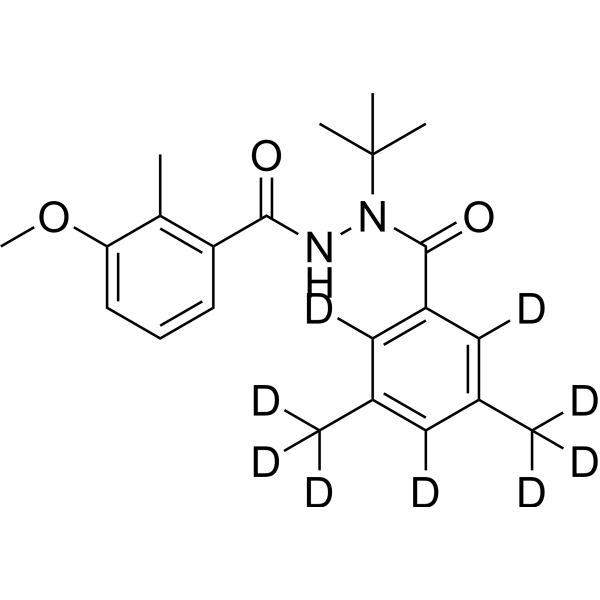Methoxyfenozide-d9
Modify Date: 2024-01-10 12:45:56

Methoxyfenozide-d9 structure
|
Common Name | Methoxyfenozide-d9 | ||
|---|---|---|---|---|
| CAS Number | 2469014-53-5 | Molecular Weight | 377.52 | |
| Density | N/A | Boiling Point | N/A | |
| Molecular Formula | C22H19D9N2O3 | Melting Point | N/A | |
| MSDS | N/A | Flash Point | N/A | |
Use of Methoxyfenozide-d9Methoxyfenozide-d9 is the deuterium labeled Methoxyfenozide[1]. Methoxyfenozide, a diacylhydrazine insecticide, selectively binds to lepidopteran ecdysone receptors (EcRs) over dipteran EcRs with Kd values of 0.5 and 124 nM, respectively. Methoxyfenozide is lethal to neonatal larvae of S. exigua, S. frugiperda, T. ni, O. nubilalis, L. pomonella, H. zea, and H. virescens (LC50s=0.35, 0.2, 0.11, 0.18, 0.21, 0.79, and 3.12 mg/L, respectively)[2]. |
| Name | Methoxyfenozide-d9 |
|---|
| Description | Methoxyfenozide-d9 is the deuterium labeled Methoxyfenozide[1]. Methoxyfenozide, a diacylhydrazine insecticide, selectively binds to lepidopteran ecdysone receptors (EcRs) over dipteran EcRs with Kd values of 0.5 and 124 nM, respectively. Methoxyfenozide is lethal to neonatal larvae of S. exigua, S. frugiperda, T. ni, O. nubilalis, L. pomonella, H. zea, and H. virescens (LC50s=0.35, 0.2, 0.11, 0.18, 0.21, 0.79, and 3.12 mg/L, respectively)[2]. |
|---|---|
| Related Catalog | |
| In Vitro | Stable heavy isotopes of hydrogen, carbon, and other elements have been incorporated into drug molecules, largely as tracers for quantitation during the drug development process. Deuteration has gained attention because of its potential to affect the pharmacokinetic and metabolic profiles of drugs[1]. |
| References |
| Molecular Formula | C22H19D9N2O3 |
|---|---|
| Molecular Weight | 377.52 |